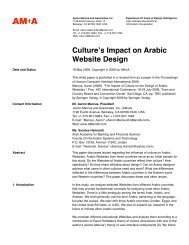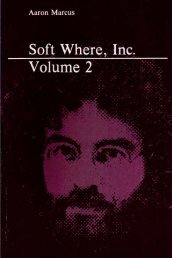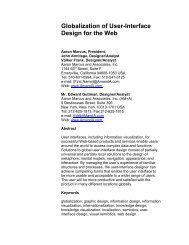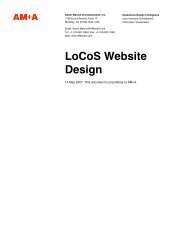AM+A.SciFi+HCI.eBook.17Aug12 - Aaron Marcus and Associates, Inc.
AM+A.SciFi+HCI.eBook.17Aug12 - Aaron Marcus and Associates, Inc.
AM+A.SciFi+HCI.eBook.17Aug12 - Aaron Marcus and Associates, Inc.
Create successful ePaper yourself
Turn your PDF publications into a flip-book with our unique Google optimized e-Paper software.
<strong>Aaron</strong> <strong>Marcus</strong>, The Past 100 Years of the Future, Page 4<br />
Abstract<br />
During the past hundred years, science-fiction (sci-fi) films <strong>and</strong>, later, videos, have, of<br />
necessity, had to depict detailed views of human-computer interaction (HCI) of the<br />
future, or alternate pasts/presents, in order to convey a compelling scene <strong>and</strong>,<br />
sometimes, in order move forward the plot. This publication explores some of the<br />
themes that emerge from examining this body of work. The l is simple: HCI<br />
professionals can learn something from sci-fi media, <strong>and</strong> sci-fi media-producers can<br />
learn more from HCI professionals in order to show smarter views of the future.<br />
Article Text:<br />
Sci-Fi <strong>and</strong> HCI: Past, Present, <strong>and</strong> Future<br />
“Greeting HCI/CHIons of the Planet Earth. I bring you a message of great import. May<br />
the Schwartz be with you in your quest for knowledge of excellent user experiences….”<br />
So might the opening of the Academy Awards of 2014 for Human-Computer Interaction<br />
(HCI) in movies <strong>and</strong> videos begin…but such is not the case...In the meantime, please<br />
join with me in this romp through time, space, fiction, <strong>and</strong> reality.<br />
Movies <strong>and</strong> video programs of traditional broadcast media over the past hundered years<br />
have made extensive use of computer-human interaction in telling science-fiction stories<br />
that envision the future or alternate worlds of the past or present. In the following<br />
publication, I present a personal <strong>and</strong> roughly chronological essay. This survey provides<br />
examples of HCI included within movies <strong>and</strong> videos that I presented in my keynote<br />
address at the Mensch und Komputer Conference 2011 in Chemnitz, Germany. I am<br />
indebted to Prof. Dr. Maximilian Eibl <strong>and</strong> to Dr. Arne Berger for their invitation to present<br />
the results of my study (see the online video cited in the Bibliography).<br />
I provide an early warning: This text is not an academic treatise, but more like a<br />
travelogue of past futures. Besides informing <strong>and</strong> entertaining you, I hope it will inspire<br />
PhD students worldwide <strong>and</strong> others to explore further the topics mentioned. My<br />
comments are a compendium of insights gained from viewing many of these works with<br />
an eye trained for decades to notice the details that inspire, frustrate, <strong>and</strong> inform us as<br />
user-experience (UX) <strong>and</strong> user-interface (UI) or human-computer interaction (HCI)<br />
design professionals.<br />
How old is science-fiction story-telling? Depending on how you define this genre, one<br />
can go back to visions of the future that date at least from the time of Roger Bacon,<br />
noted philosopher <strong>and</strong> scholar, who in 1260 CE/AD commented that someday…<br />
“Machines may be made by which the largest ships, with only one man steering them,<br />
will be moved faster than if they were filled with rowers; wagons may be built which will<br />
move with incredible speed <strong>and</strong> without the aid of beasts; flying machines can be<br />
constructed in which a man…may beat the air with wings like a bird…machines will<br />
make it possible to go to the bottom of seas <strong>and</strong> rivers.” [De secretis operibus, c. 4. ed.<br />
Cit. 533; cf. L. Thorndike, History of Magic <strong>and</strong> Expermental Science, ii (1929), 654-5; F.<br />
Boll, “Technische Träume des Mittelalters”, Die Umschau, xxi (1917, 678-80, all cited in<br />
White, Lynn, Jr. (1962). Medieval Technology <strong>and</strong> Social Change. London: Oxford, p.<br />
4






